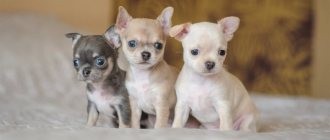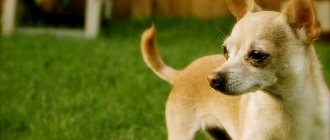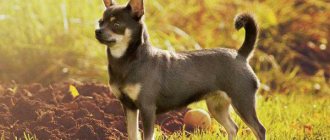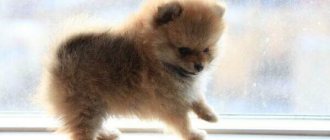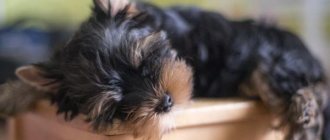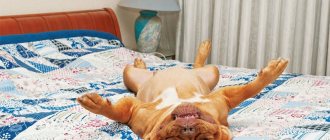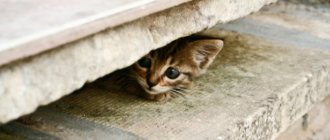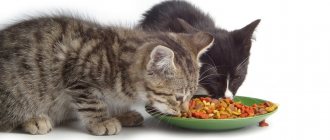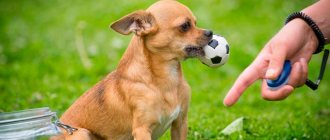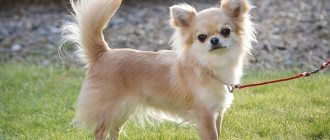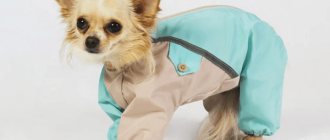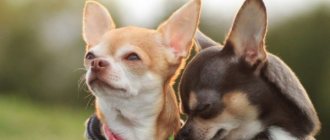Hello, dear reader! This page will help you correctly identify a Chihuahua dog and easily choose and buy a puppy of this particular breed. All little puppies are very cute, but how not to make a mistake with your choice? If you are choosing a puppy for love, then familiarize yourself with the characteristics of the breed. But, if you are really interested in the breed of the puppy, then it is a good idea to study the breed standard and find out what documents the puppy must have . Naturally, the price of puppies varies. But even an inexpensive Chihuahua puppy must meet the standard of its breed as much as possible.
Chihuahua standard
Chihuahua breed standard FCI-Standard N° 218 / 09.15.2010 / GB
BRIEF HISTORICAL SUMMARY: The Chihuahua is considered the smallest dog in the world and is named after the largest state of the Mexican Republic (Chihuahua). There is an assumption that these dogs lived in the wild, and during the Toltec civilization, they were domesticated. Images of a small dog called "Techichi" were used as decorations in urban architecture found in the city of Tula. These sculptures closely resemble real Chihuahuas .
TRANSLATION: K.Barbosov (source FCI-Standard N° 218 / 09/15/2010 / GB)
ORIGIN: Mexico. PUBLICATION DATE OF THE CURRENT OFFICIAL STANDARD: 07/29/2009 APPLICATION: Companion Dog CLASSIFICATION: Group 9 – Companion and Small Dogs Section 6 – Chihuahua No working tests
Where is the best place to buy
To choose a Chihuahua, you must first decide where the animal will be purchased. You should not make a choice in favor of pet stores and especially the market, since these places are dubious and the chances of purchasing a healthy pet are much lower. You should only buy a dog from specialized nurseries, but you shouldn’t let your guard down here either.
It is no secret that the cost of puppies of this breed is quite high, so some unscrupulous sellers, frankly speaking, abuse animals for the sake of profit. So, for example, they can save on dog food or use females as a machine for producing offspring, not allowing them to really recover from previous births. Naturally, in such conditions there is no need to even talk about healthy puppies.
We recommend this article:
All about the breed and buying a pocket mini Chihuahua
To avoid encountering such sellers, pay attention to the conditions in which children are kept. The cage in which they are kept must be clean and the food must be of high quality. Also, a good breeder from whom you take a Chihuahua will always be able to provide you with all the necessary information about the pet’s pedigree, and even show you its parents if you want. The dog must have a veterinary passport with all the necessary data. In addition, the litter to which the puppy belongs must contain no more than five individuals. If everything is in order, feel free to purchase a pet.
Similar article: How to make a house for a Chihuahua with your own hands
Head
Skull part:
Skull: Well rounded, apple-shaped (breed characteristic). Stop: Well defined, deep and wide, as the forehead is rounded and sits (“overhangs”) above the muzzle.
Front part:
Nose: any color is allowed. Moderately short, slightly upward. Eyes: Large, round, very expressive, not protruding, completely dark. Light eyes are acceptable, but not desirable.
Ears: Large, erect, wide open, wide at the base, gradually tapering to slightly rounded tips. At rest they are tilted at an angle of 45° .
Muzzle: Short, straight when viewed in profile, wide at the base, tapering towards the tip of the nose. Lips: Dry and tight fitting. Cheeks: poorly developed, very clean.
Jaws/Teeth: Scissor or level bite. Overshot, undershot, as well as any other anomaly in the position of the upper or lower jaw should be strictly punished.
Neck :
With a slightly pronounced scruff. Middle length. Thicker in males than in females. No suspension. In the long-haired variety, the presence of a “mane” is highly desirable.
Frame :
Compact and well balanced. Topline: horizontal. Withers: Slightly defined. Back: Short and strong. Loin: Very muscular. Croup: Broad and strong, almost straight or slightly sloping. Chest: Broad and deep, ribs well sprung. When viewed from the front, it is voluminous, but not extensive. When viewed from the side, it reaches the elbows. Not barrel-shaped. Underline and belly: Well defined, with a well-tucked belly. A sagging (weak) belly is acceptable, but not desirable.
Tail :
Set on high, straight, of medium length; wide at the base, gradually tapering towards the tip. The carriage of the tail is an important breed characteristic: when in motion it is carried either high, curved or in the shape of a semicircle with the tip directed towards the lumbar region, which gives balance to the body. The tail should never be carried between the hindquarters or below the line of the back. The hair on the tail depends on the coat variety and must correspond to it. In the long-haired variety, the hair on the tail forms a plume. When at rest, the tail is lowered and forms a small hook.
Gender of the puppy
Perhaps choosing the gender of a puppy is the only decision that should be made intuitively. Already at puppyhood, a boy and a girl behave differently. Typically, females grow and develop faster. Contrary to popular belief, Chihuahua males are more loyal and obedient. Bitches are more picky when it comes to training and even when it comes to food.
Many potential owners choose the Skook because it will not mark territory. We dare to disappoint you, girls also mark, and not so rarely. A non-breeding male can be neutered, which will eliminate the issue of wet corners forever. If the boy is a potential sire, it will be easier to potty train him.
Tip: During puberty, even perfectly trained dogs can mark their territory. If sterilization or castration is not possible due to breeding value, it is recommended to use hygiene belts for dogs.
The weaker half of the Chihuahua also has advantages. For example, they like to sit on their hands more and bark less. Boys love to guard the apartment and the owner , which often results in barking at the door. Males are prone to fights with dogs of the same sex, even if the opponent is much larger. Girls remain playful into adulthood and are willing to learn; males become proud.
Interesting! The theory does not cover all the features of the development of puppies of different sexes; upbringing also plays a significant role. In the absence of socialization or lack of walks, the dog will be nervous and may start biting or running away, and this does not depend on gender.
Limbs:
Forelegs:
General appearance: The forelimbs are straight and parallel when viewed from the front. Vertical when viewed from the side. Shoulders: Smooth and moderately muscular. The angles of the humeroscapular joints are well defined. Elbows: Strong and close to the body, allowing free movement. Forearms: Straight and of good length. Pasterns: Slightly sloping, strong and flexible. Feet: Very small and oval, with well-spaced but not splayed toes (neither hare's nor cat's feet). The claws are well arched and moderately long. The pads are well developed and very elastic. Dewclaws are not desirable.
Hind limbs:
General appearance: The hind legs are muscular with long bones, vertical and parallel to each other, with good angulation of the hip, knee and hock joints, in harmony with the angulation of the forelegs. Metatarsals: hocks are short, with well-developed Achilles tendons; when viewed from behind, straight and vertical are well spaced from each other. Feet: Very small and oval, with well-spaced but not splayed toes (neither hare's nor cat's feet). The claws are well arched and moderately long. The pads are well developed and very elastic. Dewclaws are not desirable.
Movements:
The steps are long, elastic, energetic and active, with good reach of the front legs and drive of the hind legs. When viewed from behind, the hind legs should move almost parallel to each other, so that the tracks of the hind legs coincide with the tracks of the front ones. With increasing speed, there is a tendency for the center of gravity to shift (single step). The movements are stable, free and springy, without visible effort, the head is raised, the back is straight.
Leather:
Smooth and tight fitting throughout the body.
At what age do Yorkies change color?
For some, recoloring begins at 3.5 - 4 months, for others at 9 - 10 months, and there are those that acquire their own color
by 2 years.
Typically, the dog that takes the longest to complete this process will have a good color
.
Interesting materials:
What should be in an employment contract? What should be in the accounting policy? What should an individual entrepreneur have on his seal? What must be included in a decision in absentia? What is more expensive: primary or secondary housing? What is secondary education? What is CPT? What is this gsm? What is this license? What kind of profession is an accountant?
Wool
There are two varieties in the breed:
Shorthair:
The coat is short and lies tightly all over the body. If there is an undercoat, the coat is somewhat longer; sparse hair on the throat and belly is allowed; slightly longer on the neck and tail, short on the head and ears. The coat is shiny and its texture is soft. Lack of wool is not allowed.
Longhair:
The coat should be fine and silky, smooth or slightly wavy. A not too thick undercoat is desirable. The coat is longer and forms feathers - on the ears, neck, on the back of the front and hind legs, on the paws and tail. Long flowing hair is not acceptable.
Color:
Any color is acceptable , with the exception of merle color.
Size and weight:
In the breed, only weight is taken into account, not height. Weight: Ideal weight: from 1.5 to 3 kilograms. Weight from 500 gr. up to 1.5 kg is acceptable. Dogs weighing less than 500 grams and more than 3 kg must be disqualified.
Main selection criteria
The first and most important recommendation, if you want to choose the right Chihuahua puppy, do not give free rein to your emotions! Choosing a pet based solely on color, eye color or size cannot be considered adequate. Unfortunately, many Chihuahua puppies are born sick and are successfully sold to inexperienced owners every year. Within a few months, the owners find out that their ward has a hereditary illness, a disease of the musculoskeletal system, is affected by worms, etc. If you are not tempted by the prospect of year-round treatment for your pet and sleepless nights in fear of losing it, you will have to be vigilant at the stage of buying a puppy.
Important! There is nothing wrong with saving a life by sheltering and treating a sick Chihuahua puppy. However, if you take this step, you must clearly know what health problems have already been diagnosed and how to treat them. Naturally, paying the full cost of the puppy is out of the question.
Below are techniques for identifying obvious problems. Only a veterinarian can identify genetic or hidden diseases (and even then not always). Be sure to show the puppy to a doctor before purchasing, even if the breeder has reports from “your doctor.” So, the initial examination should exclude:
- Presence of fleas and ticks - inspect the fur and skin of the puppies and their mother. Pay attention to the general environment, the cleanliness of the litter, the presence of dust, the freshness and humidity of the air.
- Lethargy and obvious weakness - detected by observing the litter during the game of eating or immediately after waking up. This assessment is difficult to do because young puppies sleep a lot.
- Poor quality wool and bald patches are a clear sign of an unbalanced diet, poor care or the presence of pathologies.
- Discharge from the eyes, ears, wounds or ulcers in the mouth indicate an infectious lesion in the litter.
- Neurological disorders - noticeable by poor coordination during games.
- Problems with joints and bones - the puppy should not limp, have swelling or swelling on the paws.
- Bad breath and dental problems are identified through examination.
- Problems with digestion, worms - puppies defecate 15-20 minutes after eating and you need to wait for this “action”.
- Hydrocephalus is identified by the irregular shape of the head and neurological abnormalities.
- Blindness and deafness - checked by deliberately irritating the senses, clapping, calling.
During the examination, immediately pay attention to the temperament of the puppies. The leader of the litter will be the bravest, he will defiantly grab a toy or boldly run out to meet you. Sanguine and choleric people will play, tease each other and will definitely pay attention to you. Phlegmatic people will look at you with a calm gaze or will sleep, not paying attention to the situation. Melancholic people usually sit on the sidelines, yawn and watch the outrage of their brothers and sisters.
Flaws
Any deviation from the above points should be considered a fault, and the seriousness with which the fault should be regarded should be in exact proportion to its degree and its effect on the health and welfare of the dog. • Missing teeth. • “Double teeth” (preservation of temporary teeth). • pointed ears. • Short neck. • Long body. • Humped or sunken back (lordosis or kyphosis). • Beveled croup. • Narrow or flat chest. • Tail: incorrectly set, short or curled. • Short limbs. • Loose elbows. • Narrow set of hind legs.
Tricks you shouldn't fall for
Not all breeders behave correctly. This is understandable: their main task is to sell puppies. So before buying a Chihuahua dog, you need to find out what tricks they use:
- Do not think that from three months you can participate in exhibitions. No matter what the owner says, you can start at eight.
- Don’t believe that a dog’s temperament will change with age; a Chihuahua’s character is stable.
- The breeder cannot justify the external differences of the dog by its foreign origin.
- There is no point in purchasing a Chihuahua without a pedigree or birth certificate; only with them can you prove the breed of the animal.
- Discounts for registering an animal without documents indicate the seller’s dishonesty.
- Contrary to some theses, puppies cannot be sold under the age of 45 days after birth.
These tricks cause people to purchase puppies that are unhealthy or not ready to go. In the future they may well grow into nervous or sickly dogs. Be aware of how unscrupulous breeders behave, and then you and your future dog will not become their victims.
Disqualifying faults
• Aggressive or overly fearful. • Any dog clearly showing physical or behavioral abnormalities must be disqualified • Dogs with an open fontanel. • Cropped or short ears. • Deformed jaws. • Extremely long body. • No tail. • In the long-haired variety: dogs with very long, fine and flowing hair. • In the short-haired variety: baldness (alopecia). • Merle color. • Dogs weighing less than 500 grams. and more than 3 kg. NB: Males must have two apparently normal testes, fully descended into the scrotum.
- Post from 04/24/15
- National Chihuahua Breed Club
Girl or boy
Another question that often plagues people planning to buy a Chihuahua: is it a boy or a girl? Who is better? Whom to choose? In fact, both boy and girl Chihuahuas are both good, the difference is not too big.
If, thinking about who to choose, you have chosen a female Chihuahua, be prepared for the fact that she will be in heat twice a year. This continues for one to two weeks, and your pet may inadvertently stain your furniture. This problem can be solved with the help of special diapers or, if the individual is clean, she will take care of herself.
Another problem may be pregnancy and difficult childbirth, but if you do not plan to breed, just keep your pet from relationships with the opposite sex. In general, girls are clean, mark their territory much less, and are very easy to train.
We recommend this article:
Description and behavioral characteristics of the miniature Chihuahua breed
With a boy, be prepared for fights with other dogs. In addition, male dogs often mark their territory, and this will either have to be weaned off or castrated. In addition, they are less willing to train than females, although at exhibitions the percentage of prizes for males is much higher. If you choose a male dog, you will need to put in more effort to get along with the dog. But for a person who loves animals, this should not be a big problem.
Related article: How old do Chihuahua dogs grow?
So, who should you choose - a boy or a girl? Weigh the pros and cons and choose someone you can get along with. After all, the main thing is to give your pet your love.
We recommend this article:
Who is better and who to choose: Chihuahua or Toy Terrier
Nutrition
A dog's daily food intake is calculated depending on its weight. The calculation formula is 70 grams of food per 1 kg of animal weight. That is, if it weighs 2 kg, then it should eat about 150 grams of food per day. It is not recommended to overheat the animal. Firstly, this will harm his health, and secondly, it will lead to disqualification at the show exhibition, since only slender representatives of the breed are allowed by the standard.
A Chihuahua puppy should eat 5 times a day, at the same time of day and evening. It should be fed with low-calorie and high-quality foods, such as:
- Yogurt.
- Cottage cheese.
- Chicken.
- Skimmed milk.
- Cereals cooked in water without salt.
- Cucumbers, tomatoes.
- Apples, cherries, raspberries.
- Greenery.
- Beans, broccoli.
Thanks to eating the above foods, his body will quickly form and his immunity will become stronger. We recommend switching an adult dog of this breed to wet food. This product is perfect for him. In addition, the owner will not have to waste time preparing food for his pet.
Important! If your pet is overly active, he will need more carbohydrates, so giving him food alone is not enough. Feed your energetic dog nuts, such as walnuts, and bone cartilage. This will allow him to remain perky throughout the day.
Owner reviews
According to the owners of the Chihuahua, the appearance of such a dog in the house is akin to the birth of a small child. This breed requires careful and regular care, constant attention, good feeding and close health monitoring. But all this is worth the return that owners of small pets receive. They are funny, funny and smart. You won't get bored with them.
In general, the Chihuahua, according to numerous reviews, is a kind and grateful animal. And if you give this dog your attention, it will thank its owner with its love and devotion.
Interesting topics
- Papillon dogs - dwarf spaniels
- Description of the German Spitz dog breed
- Common breeds of small domestic dogs and recommendations for choosing them
- Shar Pei: breed characteristics and proper care
- Dalmatians are so popular in movies
- Features of the Japanese dog breed Shiba Inu
Weight table by month
The most reliable and accurate forecast of how much a pet should weigh can be given by its pedigree. Size, like some other parameters, is inherited. But to determine the approximate weight, you can use the weight table for Chihuahuas.
| Age/Weight of the newborn, gr. | 70 | 80 | 85 | 100 | 110 | 120 | 130 | 145 | 155 |
| 1 Week | 106 | 113 | 142 | 156 | 184 | 198 | 227 | 255 | 269 |
| 4 weeks (1 month) | 198 | 227 | 269 | 312 | 369 | 452 | 482 | 539 | 595 |
| 8 weeks (2 months) | 312 | 369 | 454 | 539 | 610 | 680 | 765 | 822 | 936 |
| 12 weeks (3 months) | 425 | 539 | 624 | 737 | 851 | 936 | 1049 | 1162 | 1276 |
| 16 weeks (4 months) | 567 | 709 | 851 | 964 | 1106 | 1247 | 1389 | 1531 | 1673 |
| 20 weeks (5 months) | 680 | 851 | 992 | 1162 | 1304 | 1474 | 1644 | 1814 | 1985 |
| 25 weeks (6 months) | 765 | 946 | 1134 | 1332 | 1503 | 1701 | 1899 | 2070 | 2269 |
| 18 months | 908 | 1135 | 1362 | 1589 | 1816 | 2043 | 2270 | 2497 | 2724 |
To read: All standard and unique Doberman colors: detailed description of colorings
Estimated weight by one and a half years at a weight of 2 months:
| Weight at 2 months | Final weight of an adult dog |
| 0.30 kg | 0.90 kg |
| 0.36 kg | 1.15 kg |
| 0.45 kg | 1.35 kg |
| 0.55 kg | 1.60 kg |
| 0.60 kg | 1.80 kg |
| 0.70 kg | 2.05 kg |
| 0.76 kg | 2.25 kg |
| 0.93 kg | 2.71 kg |
| 1.10 kg | 3.18 kg |
Price
Lovers of miniature indoor dogs can purchase them in almost any modern city. There are prestigious nurseries in capitals, including Moscow, Kyiv and Minsk. It is recommended to buy the animal there. The reason is the opportunity to make money from it in the future.
Dogs that fully comply with the breed standard are allowed to participate in all kinds of show exhibitions and competitions. If they take prizes, then the owner has the right to significantly increase the price of their offspring.
The average price of a Chihuahua in 2022 in the Russian Federation is 20 thousand rubles. Puppies born from titled parents in prestigious nurseries are sold for 30 thousand rubles. Private traders who do not provide guarantees that an animal meets the standard of its breed cannot inflate the price for it. They offer to purchase Chihuahua babies for 5-15 thousand rubles.
Temperament and appearance
The Mexican Chihuahua has always been famous for its tiny size and strong-willed character. It was revered in ancient times; it was believed that the dog drives away evil spirits and protects its owner. Like a guardian angel, the Chihuahua is still a constant companion of the entire female population, and children are crazy about Chihuahuas.
She attracts them with her comical nature, funny face, puny body and wit in her eyes. It is convenient to take dogs with you to work, on trips, moving, and on a walk it is convenient to carry them under your arm through puddles and obstacles. What can I say, the dog is comfortable in every sense. Is this how Chihuahuas like to live near people? Let’s find out.
In fact, a Chihuahua is happy with everything if you take care of it properly. She skates, frankly, like cheese in butter. The modern words from the song “Why are you so impudent” suit her perfectly. Why do you ask, because sneeze is so cute and tiny...
But its cuteness does not mean that the dog is calm; on the contrary, with a Chihuahua you are always like behind a stone wall; it, of course, will not be able to cripple an enemy, but it will be able to bark at your enemy or an evil passer-by with pleasure.
Not only does she have the temperament of a winner, but she also has selfish tendencies. So if strangers come to you, the dog will not trust them, it will growl and in every possible way will not allow contact with you until it understands that it is also loved and feels your affection. Take her in your arms when guests arrive, talk not only with the guests, but also with her, pet her and scratch her withers, the Chihuahua loves this very much.
However, if it is problematic for you to devote so much time to your Chihuahua, it is better to refuse to buy a puppy. A dog suffers greatly from loneliness, it can get sick and in general, when depressed, it will think that it is abandoned by everyone and forever. Depression in a Chihuahua can have disastrous consequences.
Additionally, Chihuahuas need care that you wouldn't give any other breed, or so they think. The upbringing and socialization of a Chihuahua comes first, since due to its belligerent nature and hot temper, it can find itself in a dead end situation or even harm its health, have an accident or be bitten by a big dog.
So, let's move on to the main thing where we started our conversation - how to choose a Chihuahua, how to choose the color and gender. And also how not to make a mistake when coming to the nursery and not choose a sick Chihuahua for yourself, read on.
Health problems
Little Chihuahuas should receive regular vaccinations. The first vaccinations are given by the breeder, which is reflected in the veterinary passport. Also, we must not forget to treat the animal from fleas, worms and ticks in a timely manner.
Miniature Chihuahuas are not the healthiest dogs. The smaller the size, the more health problems. They are prone to hydrocephalus and hypoglycemia. In the latter case, the dog often faints. If this happens, the animal needs to be shown to a veterinarian immediately. Glucose injections help relieve an attack.
And the owner should remember that the pet:
- Increased physical activity should not be given;
- a strict feeding regime is indicated (and food is divided into small portions);
- Sometimes you need to pour sweetened water.
Chihuahuas are prone to obesity, and excess weight can provoke bone diseases. Another common problem is tartar.
Toilet training
Every living creature has a natural need to relieve itself. When keeping a Chihuahua at home, the owner should take care to provide a place where the dog can defecate with impunity. Place a tray with absorbent filling or diaper. Otherwise, feces and urine will end up in unexpected places in the apartment, for example, in the owner's shoe. Unexpected surprise?
The puppy should be toilet trained from the first days. There is no need to punish any mistake. You need to be restrained, not allow yourself to be assaulted, and not poke your puppy’s nose into the feces. Such actions will generate fear and apprehension and will worsen trusting relationships.
Additional recommendations
When picking up a puppy from the nursery, you should definitely ask the breeders what diet is acceptable for the baby and what actions should be taken to ensure a more successful adaptation of the pet to the new family.
A radical change in diet can cause digestive system disorders, which can only be brought back to normal with medication.
Long-haired Chihuahuas have a friendlier character than short-haired ones. The latter are calmer and more balanced.
Breed Features
Let's talk about exterior features and character nuances.
The most important external feature of a Chihuahua puppy is its ears. Huge, widely spaced, they resemble locators.
Another distinctive feature is the wool. These dogs come in long-haired and short-haired varieties. The long coat curls beautifully at the bottom. The pet needs to be combed three to four times a week.
How to choose a Chihuahua puppy? Paying attention to character traits, first of all:
- Chihuahuas are very jealous. They get along with other pets, of course, but they will feel uncomfortable when doing so. It is better to take a representative of the breed as the only pet in the family.
- Dogs do not tolerate loneliness well. If the owner is constantly away from home, the baby will begin to get bored and waste away. Can get sick from loneliness.
- They are curious, they need everything and everything is interesting.
- It was already mentioned above that the Chihuahua is alien to cowardice. Getting into a fight with a large dog is no problem.
- They don't tolerate people raising their voices.
- With proper upbringing, they are restrained and silent, and will not bark over trifles.
Correct bite
Particular attention should be paid to the teeth and bite of your Chihuahua puppy. As a standard, at two months the puppy should already have twelve teeth (an equal number on the upper and lower jaws).
However, there are exceptions to the rules. An important parameter is the correct bite. This means that the upper jaw should completely cover the lower jaw.
But this does not ensure one hundred percent preservation of the correct bite in adulthood. But the initial malocclusion usually gets worse during the process of changing to molars.
Dogs with this defect are not allowed for breeding and do not take part in exhibitions. They are purchased only as a pet.
It is impossible to determine in advance whether a dog’s bite is correct; this is the specificity of the Chihuahua breed.
Height and weight of the puppy. The largest puppy from the litter may eventually become no larger than its brothers. Likewise, large parents sometimes give birth to mini Chihuahuas.
Before purchasing a Chihuahua puppy, you should still familiarize yourself with its pedigree. When studying genealogy, the main interest is in the uniformity of the line.
The uniformity of the line confirms the correct culling of dogs that did not meet the requirements of the breed standard. This indicator is especially important for future exhibition participants.
The length of the body is slightly greater than the height at the withers. However, an almost square format is preferred, especially in males. In females, a more extended format is acceptable, due to reproductive function.
Water treatments
It is enough to wash your Chihuahua with specialized shampoo once a quarter for hygienic purposes. Human shampoo is not suitable because... it can strip your dog's skin of essential oils, leading to hair loss, dryness and brittleness! You can bathe without shampoo more often if the dog likes water treatments, but without enthusiasm, no more than once every 2 weeks.
The water should be warm, optimal temperature: 35-40°C. It is important to ensure that water does not get into your ears. At the end of the procedure, wipe the dog's fur dry with a clean and warm cotton towel, or use a hairdryer.
